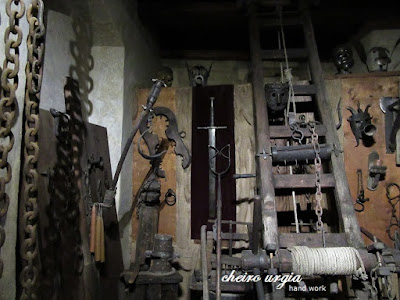Trying to avoid the masses of tourists, we decided to be there just when the areal would be opened in the morning, not without exploring the surroundings of the castle itself though.
When we arrived at the entrance (there are a couple of entrance gates in different locations, so you might pick one that suits you best depending on the direction you come from), the queque before the security check was already there. Luckily, it wasn't that bad and it even turned out to be moving quickly.
For the warmer months of the year however, I can only recommend an arrival early in the morning, some time before the gates are scheduled to open. The castle has much to offer, and you might not want to start your visit with waiting.
Anyway, under the watchful eyes of Tomáš Masaryk, the castle guards and security employees, we entered the historic seat of kings that now serves as presidential palace.
To a Slovene, the history of Prague castle is of course closely connected with the works of Jože Plečnik. Already the huge flagpoles you might notice while waiting to enter at the front entrance are his creation, and a few steps from the entrance, one can see his typical circular shapes.
Racing other tourists, we went on towards the buildings on castle ground. With its oldest parts dating back to the 9th century, it is considered to be the largest ancient castle in the world with the impressive length of 570 m, a width of 130 m, and a total area of 70.000 m2.
Maybe, the measures are the reason why your entrance ticket is valid for two days in a row - to make sure you can take your time while exploring the castle's treasures? And given it's a mixture of different architectural styles with 3 courtyards, numerous gardens, churches, palaces, towers and other things to see, there certainly is much to explore.
For sure one of the main centerpieces on castle grounds is the gothic cathedral of St. Vitus, Wenceslaus and Adalbert, or simply: St. Vitus cathedral (katedrála svatého Víta), the biggest and most important church of the Czech Republic. Already from the outside, it makes an impression with its high towers and the detailed facade, while in its interior you can find numerous chapels, royal tombs and above all, beuatiful windows of stained glass. And of course, masses of tourists.
Cyril and Methodius window by Alfons Mucha
St. Wenceslas chapel
More gold on the outside: golden window lattice and mosaic of Last judgement.
More of Plečnik, too: a granit obelisk in memory of the fallen in WWI, and the fountain-statue of St. George.
Eagle fountain - Plečnik, what else?
Behind the cathedral, some of the older parts of the castle are: the basilica of St. George and the Old royal castle.
A little further, one will land in a street lined by tiny, colourful houses. The Golden Lane (Zlatá ulička), alledgedly named after the legend it was inhabitated by alchemists looking for a way to produce gold, is nowadays a collection of souvenir shops and walk-in exhibitions on castle life. And just another opportunity to practise your skills of getting through crowds of tourists ;)
Some time in the afternoon, we decided to finish our castle visit and slowly return to the city.
Just before we leave castle grounds for good: a sneak peek onto the presidential staircase. Couldn't be more Plečnik. Metro time.
One thing you just have to love about Prague's public transport - apart from the fact that it's very clean and efficient, and free with the Prague Card: those huge stickers with detailed instructions on first-aid that are placed everywhere. I was surprised to find several of them on every tram/metro, usually on the glass doors and barriers. How cool is that?
For the rest of the day, it was time to learn about the Jewish history of Prague. The Jubilee Synagogue, the largest Jewish prayer house in the city, literally stands out amongst the buildings in Jerusalem Street with its colourful exterior.
On to the Jewish quarter (Josefov).
Maisel Synagogue. Displaying the history of the Jewish community, it has been recently renovated and has an overall modern interior with lots of interactive elements.
Old Jewish cemetery (Starý židovský hřbitov) behind next to the Klausen Synagogue. While the first is covered in literally hundreds of gravestones from past centuries, the latter - just like the Jewish ceremonial hall next to it - is turned into a museum of Jewish customs and festivals.
Not pictured: the Pinkas Synagogue just across the cemetery. With its interior walls covered with names of Czech Holocaust victims, it is a place that sends icy chills down your spine in a way that can only be topped by the exhibition of children's paintings from the Terezín concentration camp.
Last but not least: the stunning Spanish Synagogue (Španělská synagoga). Two stores high with a huge cupola and balconies lining its interior walls, its dsplays focus on recent Jewish history. The rich interior seems to be taken right from a fairytale while the photos don't do it justice in any way.
Just in front of the synagogue, the statue of Franz Kafka. If according to wiki it depicts a scene from his novel "Amerika" with the tiny man being a "political candidate during a campaing ralley", the big headless man in the picture seems to be rather a prophecy than a coincidence.
Back at the riverside, probably one of the most eye-catching buildings in town: the Dancing house (Tančící dům).
And finally, night set on Prague - Prague castle complex above the city and Vltava river.
~ to be continued ~























































































No comments:
Post a Comment